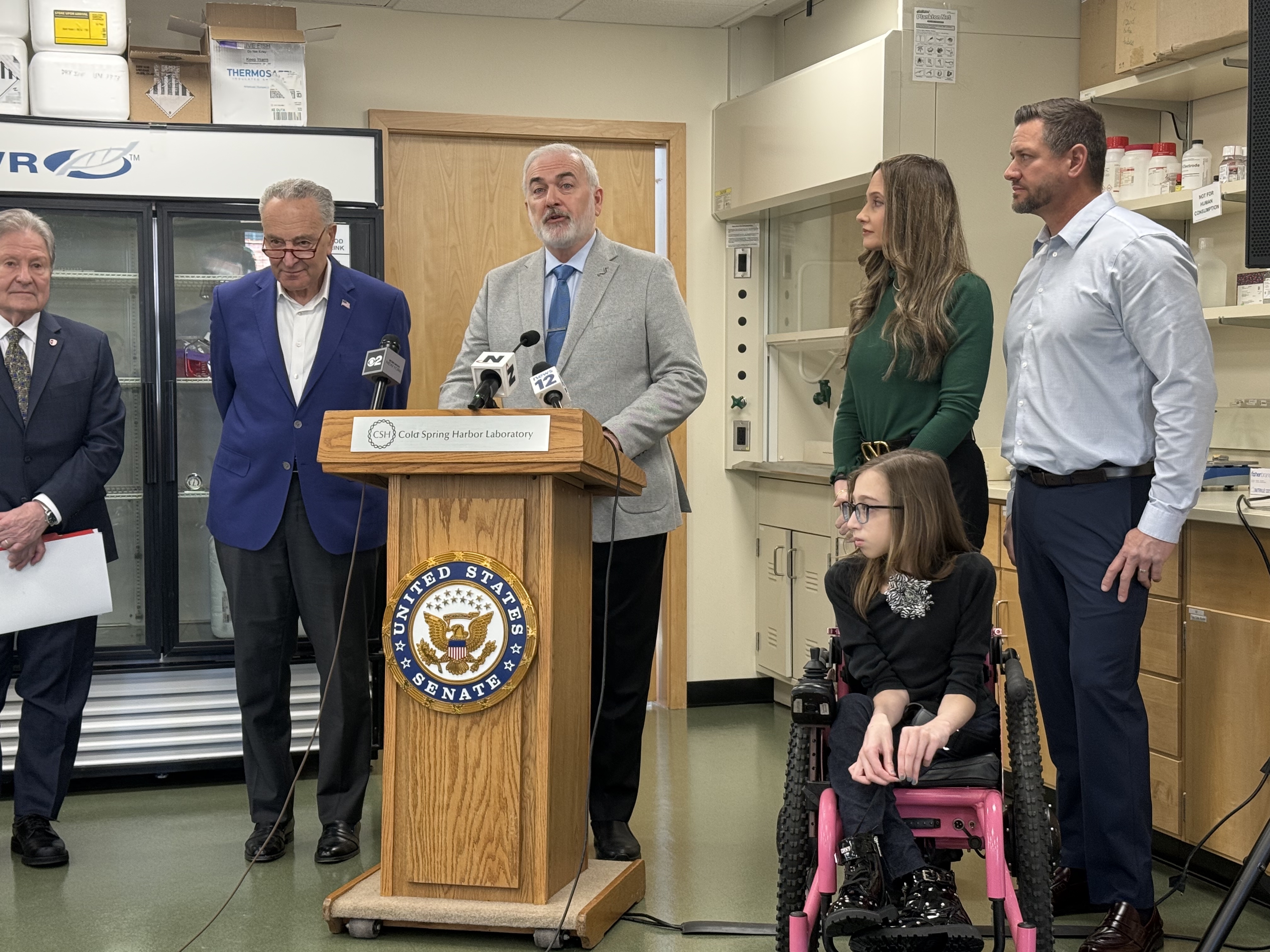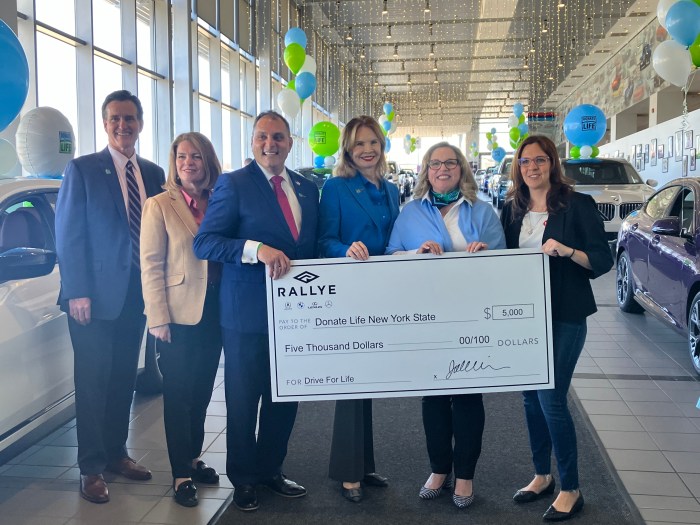Diane and Matthew Larson’s infant daughter wasn’t crawling as much as usual. Then she stopped crawling at all. And finally, even sitting up became difficult for 18-month-old Emma. The couple learned their baby had Spinal Muscular Atrophy. There was no cure, doctors said. It was likely Emma would die in early childhood.
Today, 12-year-old Emma has a 4.4 GPA. She’s learning Mandarin. She’s a die-hard Rangers fan. In her free time, she plays Fortnite with her friends. Her life — which a decade ago doctors said would be cut short — is rich and full and shows no signs of slowing down, thanks to a miracle medicine developed by Dr. Adrian Krainer right in Cold Spring Harbor Laboratory.
Those are the kinds of stories that could cease to exist if National Institutes of Health funding cuts proposed by DOGE — the Department of Government Efficiency led by billionaire Elon Musk — go into effect, critics say.

The abrupt new policy would require the NIH to limit their “indirect costs” — money that grant recipients, such as universities and labs, receive to cover practical costs related to the research, but not the research itself — to 15%. This is about half of what these grants were operating at previously.
Senate Minority Leader Chuck Schumer (D-NY) visited Cold Spring Harbor Labs on Feb. 17 to call for a bipartisan push against these funding cuts.
“Medical research is one of the great things we do here in America. We lead the world, and we’re all living longer and better and healthier,” Schumer said. “And some people who wouldn’t be alive are alive today because of the work done in these labs, and we want to cut it and call it waste?”
“Administrative costs mean microscopes, mean keeping these labs in sanitary conditions so they can do the research,” he added. “And somebody with no knowledge of how this works swoops in and says, ‘We’re going to cut it.’ No way. We’re going to do everything we can to stop it.”
Multiple U.S senators in the Republican majority have publicly opposed DOGE’s funding slashes. Cancer, Alzheimer’s, and genetic diseases are indiscriminate, and NIH grant-driven research saves lives regardless of political affiliation, Schumer noted.
“There are people behind the dollars,” Diane Larson told the Press. “I understand there’s a lot of government waste, I’m all for streamlining things and using taxpayer dollars for good things and resources, but this is something that’s good. This is something that’s saving lives. And we should re-evaluate some of the things that they’re cutting.”
Can you believe that universities with tens of billions in endowments were siphoning off 60% of research award money for “overhead”?
What a ripoff! https://t.co/RRTIMKTVYN
— Elon Musk (@elonmusk) Feb. 8, 2025
If the NIH cuts take effect, Long Island facilities could take an immediate $50 million hit, Schumer said. On top of that, Long Island would lose the economic boost that comes with being a leader in health research.
Read also: $430M BioGenesis Park to put Long Island at forefront of cell therapy
Several studies have found that every $1 spent on research returns itself severalfold due to increases in private-sector innovation. Research facilities, including Cold Spring Harbor Labs and Stony Brook University, generate billions of dollars for the Long Island economy each year. The life-saving health research and its subsequent economic engine could slow or sputter to a stop after slashes in NIH funding that was previously quite literally keeping the lights on.
“To do this [health research,] we need to not only fund the scientists and the test tubes, but we also need to have the electricity running,” said Dr. Leemor Joshua-Tor, Cold Spring Harbor Labs’ director of research.

NIH funding allowed Dr. Adrian Krainer and his team to develop Spiranza, the medicine that saved Emma’s life and has saved 14,000 more in the decade since. If babies with Spinal Muscular Atrophy receive Spiranza before they begin exhibiting symptoms, they have greatly improved life expectancies and, in many cases, can move and walk without assistance.
“And they want to take that away,” Emma told the Press, becoming emotional. “They want to put them in wheelchairs for the rest of their lives. I don’t want that. I want them to live long, healthy lives, but they’re hurting us.”
The NIH cuts are not set in stone. Congress has two chances — once in the upcoming budget reconciliation bill and again in the March 14 budget bill — to pass legislation blocking the funding slashes from DOGE, which is an entity that President Donald Trump created.
“We are forever grateful for Spinraza and the future it has given to Emma,” Diane Larson said. “I always say, ‘With science, there’s hope,’ but that comes at a cost. Without funding, we would not have these amazing discoveries and advancements. There would be no hope.”
At a glance: NIH Cuts on Long Island
- Cold Spring Harbor Labs
- $16.1 million in cuts
- Slow or stop research of: cancer, Alzheimer’s, Parkinson’s, autism, depression, schizophrenia, bipolar disorder
- Stony Brook University
- $17 million in cuts
- Slow or stop research of: health conditions in 9/11 first responders, cancer, Alzheimer’s, Parkinson’s, dementia, Lyme disease, ALS (Lou Gehrig’s disease), heart disease
- Feinstein Institute
- $17.5 million in cuts
- Slow or stop research of: cancer care, cell disorders, hospital risk reduction
- Adelphi University
- $153,000 in cuts
- Slow or stop research of: neuroscience, mental health
- Hofstra University
- $53,000 in cuts
- Slow or stop research of: heart bypass surgeries, MRI machines and eating disorders
- Brookhaven National Lab
- Cuts to its single $5.6 million grant
- Slow or stop research of: pharmaceuticals, vaccines

































